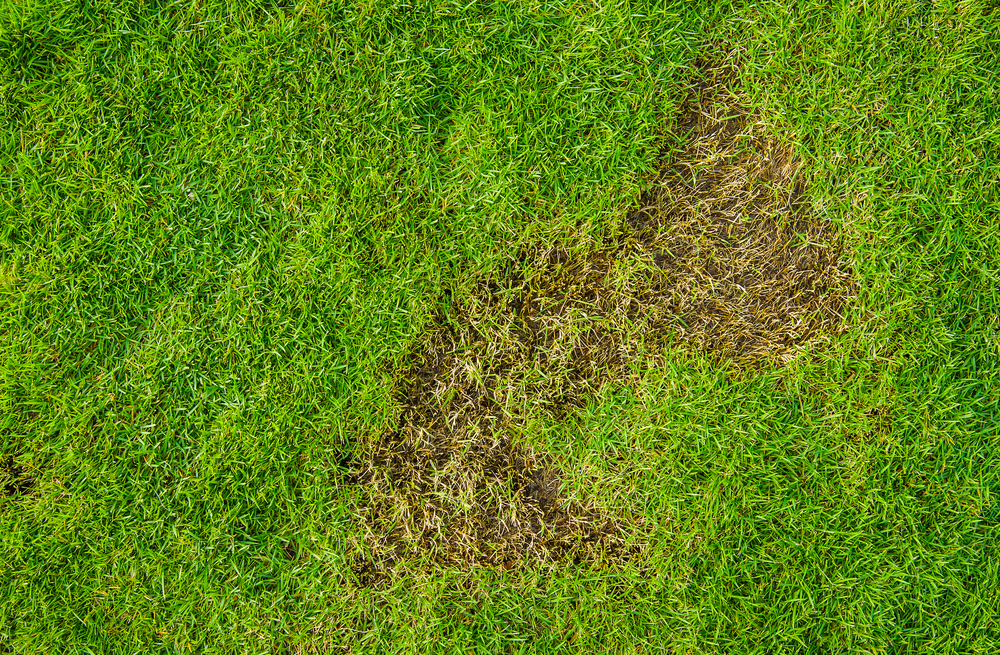
As we near the end of the growing season, wave goodbye to summer and say hello to fall, we are reflecting on some of the common questions we have been asked this year. One common question asked in the Calgary area is: We have brown spots and marks on our lawn. What do you think caused them? And what can I do to get rid of them?
Brown tracks on a lawn can be caused by various factors. Identifying the specific cause can help you take appropriate action to remedy the issue.
Here are some common causes of brown tracks on a lawn and remedies for each:
Common Causes of Brown Patches
1. Environmental Stress
Extreme weather conditions, such as drought, extreme heat, or cold, can stress the grass and cause it to turn brown.
Summer 2023 we almost experienced it all in Calgary, Red Deer and Central Alberta – periods of dry weather and extreme heat created drought like conditions; consequently brown tracks on the lawn was a common complaint.
If you had brown streaks on your lawn, that are roughly the width of a lawn mower, the tracks are likely a result of the weight of the lawn mower going across a drought-stressed lawn.
Lawns that are well-watered, the turf quickly bounces back after being walked on or mowed. Turf that is drought stressed, mower tracks and footprints show, rather than the grass bouncing back.
The good news, after some rain and/or irrigation, the turf will bounce back.
Remedy: Properly care for your lawn during these conditions by adjusting watering and maintenance practices.
2. Improper Watering
Inconsistent or inadequate watering can result in brown tracks or patches. Overwatering can also lead to root rot and brown areas.
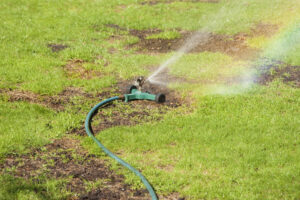
Remedy: Ensure your lawn receives the right amount of water, typically around 1 to 1.5 inches per week, and water deeply but infrequently.
Learn more about watering in our blog, “Lawn Watering Guidelines: Tips and Signs of Over and Underwatering”.
3. Soil Compaction
Compacted soil can restrict water and nutrient absorption by grass roots, leading to brown tracks or poor growth.
Remedy: Aerate the lawn to alleviate soil compaction.
Lawns should be aerated once per year in the spring or fall. Not sure if your lawn is compacted? Learn more in our blog, “Core Aeration: Signs Your Lawn Needs It”.
4. Foot Traffic
Excessive foot traffic, especially in the same areas, can compact the soil and damage the grass, resulting in brown tracks or worn paths.
Remedy: To prevent this, consider creating designated walkways or installing stepping stones.
5. Lawn Mower Damage
Mowing the lawn when the grass is wet or using a dull mower blade can cause grass to turn brown where the wheels or blades have passed.
Remedy: Ensure your mower blade is sharp, and avoid mowing wet grass. Also, try to vary your cut patterns each time you mow.
6. Lawn Disease
Fungal diseases such as brown patch, dollar spot, or other lawn diseases can cause brown or dead patches in the grass. These diseases often spread from one area to another.
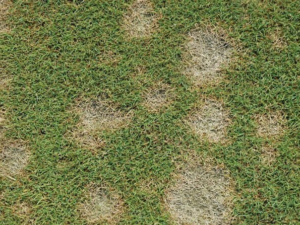
Remedy: Proper lawn care practices, such as proper watering and aeration, can help prevent diseases.
Check out our blog for “5 Lawn Diseases to Watch Out For”.
7. Insect Damage
Insects like ants, chinch bugs, or armyworms can feed on grass roots and blades, causing brown tracks or patches.
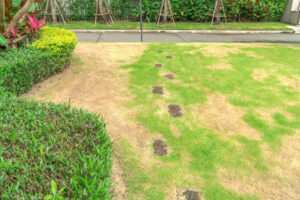
Source: Shutterstock. This is an image of a damaged lawn, due to pests.
Remedy: Identify the specific insect and treat the lawn with appropriate pesticides if necessary.
Learn more about our Insect Control Services here.
8. Dog Urine
Concentrated dog urine can burn grass, leading to brown spots or tracks.
Remedy: To prevent this, dilute urine by watering the affected area immediately after your dog urinates.
Learn more about what you can do in our blog, “Dead Spots on Your Lawn”.
9. Weed Control Products
Misapplication of weed control products, such as herbicides, can lead to brown tracks or patches in your lawn.
Remedy: Be sure to follow the manufacturer’s instructions carefully when using these products or consult the services of an expert.
10. Fertilizer Spills
Spilling or improperly applying fertilizer can lead to over-fertilization in certain areas, causing grass to turn brown or die.

Remedy: Be cautious when applying fertilizer and use a spreader to ensure even distribution or consult the services of an expert to avoid improperly applying fertilizer.
11. Chemical Spills
Accidental spills of chemicals like gasoline or oil can harm the grass, causing it to turn brown.
Remedy: Avoid using harmful chemicals near the lawn. Top up the gasoline in your lawn mower when it is parked on the driveway or someplace safe (other than the lawn). Clean up spills promptly.
To address brown tracks on your lawn, identify the underlying cause and take appropriate corrective actions, which may include adjusting your lawn care practices, applying treatments, or seeking professional help if necessary.
Regular maintenance and proper care are key to maintaining a healthy, green lawn.
We can help you get rid of dead spots on your lawn with our Overseeding and Lawn Smart Rejuvenation Packages. If you need help with your lawn or have any questions, please contact our team of lawn care specialists and they will be happy to help.
Sources:
Purdue University, Turfgrass Science at Purdue University, Department of Horticulture & Landscape Architecture, Brown Tracks in Lawn

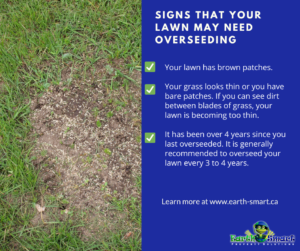

Recent Comments